We go EV racing in a… Hyundai Kona Electric!?
Hill climb racing’s pretty simple. You start at the bottom, navigate some corners, then go through a finish line at the top. They stick a clock on you to work out who does it fastest.
For something different, we did one in a Hyundai Kona Electric.
Want the latest EV news, reviews and features delivered directly to your inbox? Subscribe to our weekly newsletter!
So as not to keep you in suspense, it wasn’t the quickest car there. But it wasn’t the slowest, either. Not by a long way.

In fact, it managed the 14-corner, 1.5km run at Noosa’s fearsome hill climb in an eyebrow-raising 69-seconds. Faster, you see, than a Ford Mustang, Holden Monaro and Commodore ute (all harbouring V8s), a Porsche 944, a Ford Focus ST, a Lotus Elise S and even a Mitsubishi Evo X.
Yep, I’m as surprised as you are.

Obvious variable is the driver, but I’m hardly Lewis Hamilton. But what the Kona EV’s times clearly show is Hyundai’s pure electric SUV – weighing a portly 1800kg with a driver on board – has a bit of ability going on, even if racing was hardly the designers’ primary objective.
Want the latest electric car news and reviews delivered to your inbox? Subscribe to our weekly newsletter!
I’ll be honest, I didn’t expect this lardy, high centre of gravity range-warrior to do so well. I’m a regular at Noosa’s twice-annual hill climb, and my course PB in my 870kg 1989 Peugeot 205GTi is a second slower than the electric Hyundai. I haven’t had the heart to break this news to my French hot hatch hero yet.
A better measure of performance is versus the occasion Hyundai loaned me its hot i30N model to do the event, eliminating the driver variable. Its best time? Just 1.8-seconds faster than the Kona Electric managed, and that’s with 200kW, adjustable suspension and a very trick front differential helping drag me through tight turns.
It’s quick, but is it fun?
Alright, so speed isn’t everything.
I won’t pretend hill climbing the Kona Electric was more fun than doing so in a lightweight manual example of history’s finest hot hatch (the 205GTi, just to be clear), or Hyundai’s gem of a modern equivalent. These petrol-powered funsters with their three pedals, DIY-gearboxes, wailing four-cylinders and popping exhausts are naturally more involving, more visceral … purer.

That’s not to say the Kona EV doesn’t deliver thrills. It does. They’re just a bit different. Piloting it from the quite luxe grey leathery cabin, it’s not far removed from a video game.
There’s the go pedal and the stop pedal, no gears to manually shift – flappy paddles or otherwise – and the steering wheel to point in something like the right direction.
Then it’s a matter of ensuring you don’t overcook it and redesign the bodywork on one of Noosa’s unforgiving concrete barriers or gum trees, and, as it transpired, favouring maintaining momentum over late braking and hustling your way through a corner. The Kona EV, as I found, wasn’t at its best when in 100 percent Colin McRae attack mode.
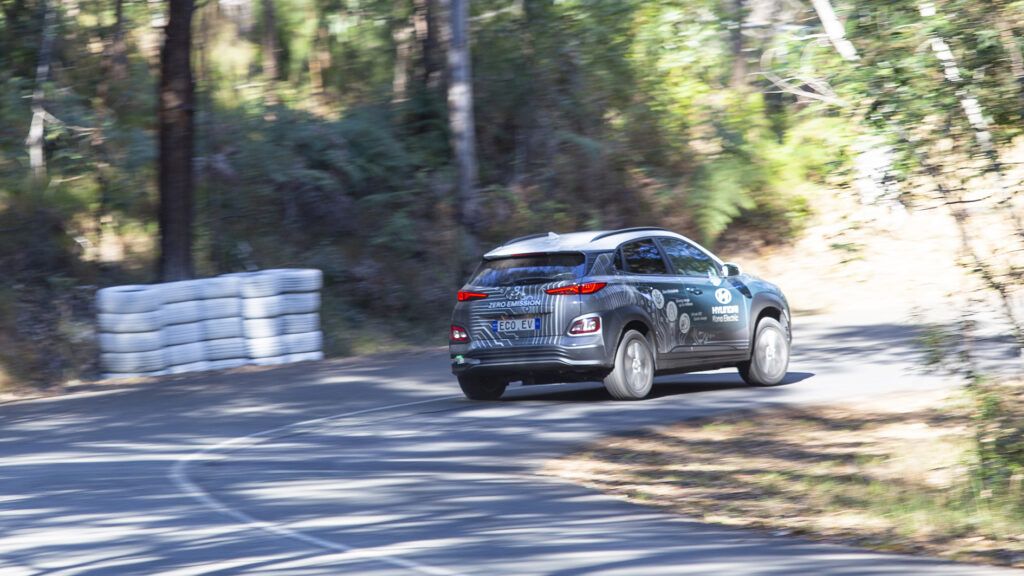
The real enjoyment came in almost re-teaching myself how to drive a car fast. The Kona EV responded best (and the times proved it) to relatively gentle application of everything – steering, brakes and throttle.
Certainly, with an electric car’s ability to deliver all its torque instantly, if you smash the accelerator with anything but a straight steering wheel the torque steer seems intent on squirreling you away from your preferred trajectory. Not ideal when the walls are testingly close on Noosa’s punishing course. Make a mistake here and consequences can get very ugly.
Adopting new driving techniques
As standard the Kona comes with eco-specific Nexen tyres, there to help it achieve its impressive 450-kilometre range. For safety reasons (and, well, to make it go faster) Hyundai switched the rubber to Michelin Pilot Sports.
You probably lose a few kilometres range due to their grippier, higher rolling resistance (they’ll result in higher road noise too), but they certainly reign in the Kona’s propensity to loudly spin the front wheels if you get too enthusiastic on the throttle.
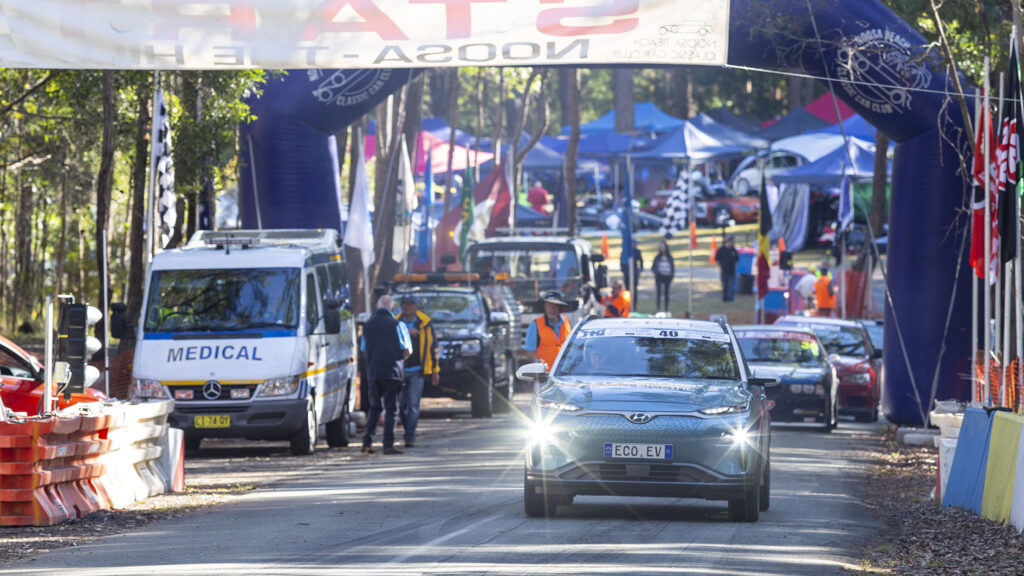
The Michelins’ grip impressed. Considering the weight of the Kona, the tyres held on well to the tight, undulating track, and thanks to the low-mounted heavy batteries, the Hyundai didn’t complain a great deal at rapid direction changes. I was expecting more body roll, but the high-rider sat reasonably flat in corners. So far, so impressive.
Steering feedback was lacking compared to Hyundai’s very well set up more performance-orientated offerings, and I found myself having a few bites at placing the car in most corners, although lack of ability on my part can be blamed here too.
Traditional racing tricks weren’t much use either. The Kona Electric being front-wheel drive, trying lift-off oversteer to transfer weight and pull the nose into a corner apex just resulted in more understeer and a killing of momentum. And it made me look silly.

No engine noise was a major aspect to get used to. It’s funny how much you rely on your internal combustion notes to inform how settled or stretched the power unit feels. The Kona EV just did its near-silent whirring, and you have to take heed of how blurry the scenery is going past your window to inform if you’re pushing your luck too much or not.
My co-driver – electric and hydrogen vehicle expert and CEO of H2H Energy, Cranston Polson – has long been adapting to the very different sensations of such cars. “I really like the electric drives for smoothness, and I love the whistle they make on acceleration,” he said. “The acceleration really surprised me the first time I got it. It’s just a matter of getting the power down.”
Having previously raced open-wheel single-seaters with next to no weight, the Kona EV experience couldn’t be much more different.
“The technique is keeping momentum and not slowing down so much,” he said. “You brake a bit earlier, smoothly hold the car and feeling the weight through the corners. I’m having a whale of a time driving it.”
Tesla smashes the opposition
So how did we do overall? A heavily modified Nissan S15 200SX was fastest overall, clocking a time of 58.8-seconds, roughly ten-seconds quicker than us. A Tesla Model 3 Performance (with recent performance updates and a 0-100km/h time of just over three-seconds, apparently) shocked many with a time of 62.4-seconds.

A home-made electric special called the Batt Mobile (geddit?) which looked like an oversized – and quite brilliant – go kart used an Advanced DC 8-inch motor powered by about a third of a Holden Volt’s battery pack, giving some 7kWh. Overall weight’s about 500kg, so this little thing flies. It managed a 68.4-second run.
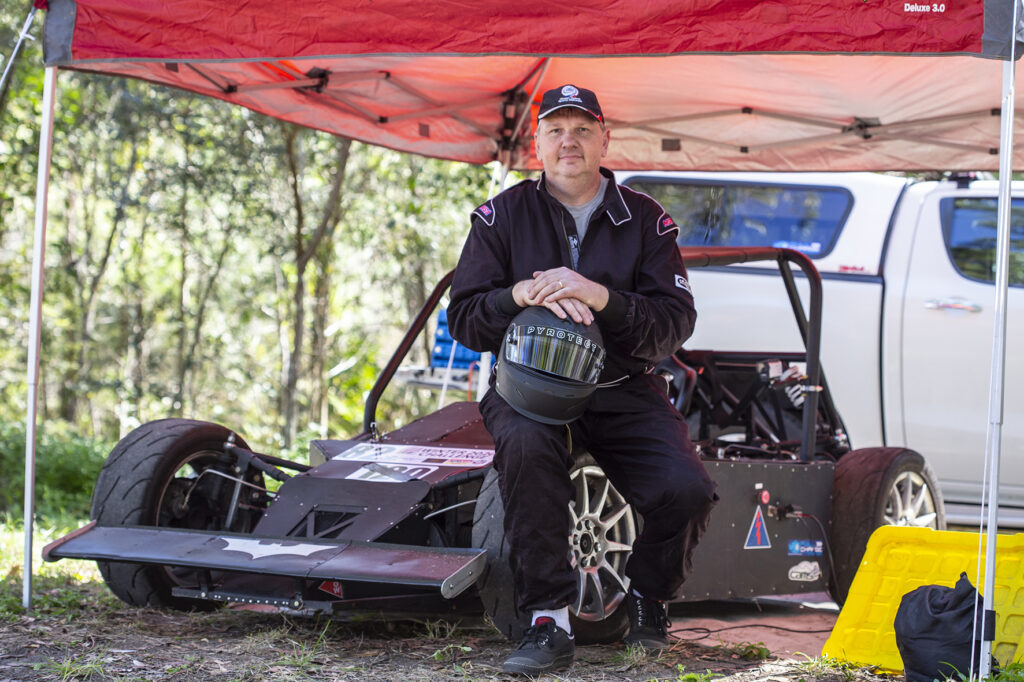
Cranston Polson (now there’s a proper racing driver’s name) and I, in our Kona EV, both achieved runs of 69.3-seconds. The fact he managed to go 1/100thof a second quicker and finish ahead in the standings isn’t worth mentioning, but it ensured I couldn’t buy him a beer afterwards.
Rapidly eating battery charge
Racing a Kona Electric had me asking questions I never thought I would. Is an electric car heavier with completely full battery charge? According to experts yes, but you’re talking about a grain of sand type weight difference between full and empty batteries.
While other racers would frantically be filling petrol tanks between runs, we just had to keep an eye on range. It was never an issue. I reset the consumption monitor ahead of a hill climb run and saw a return of 101kWh/100km.
An ugly figure – 14.3 kWh/100km is average – but as the climbs were so short, there was never need to dash to the nearest plug-point to top up. Besides, the Kona EV in maximum regen-mode could harvest power back to the batteries while driving back down the hill for another run. All very clever.
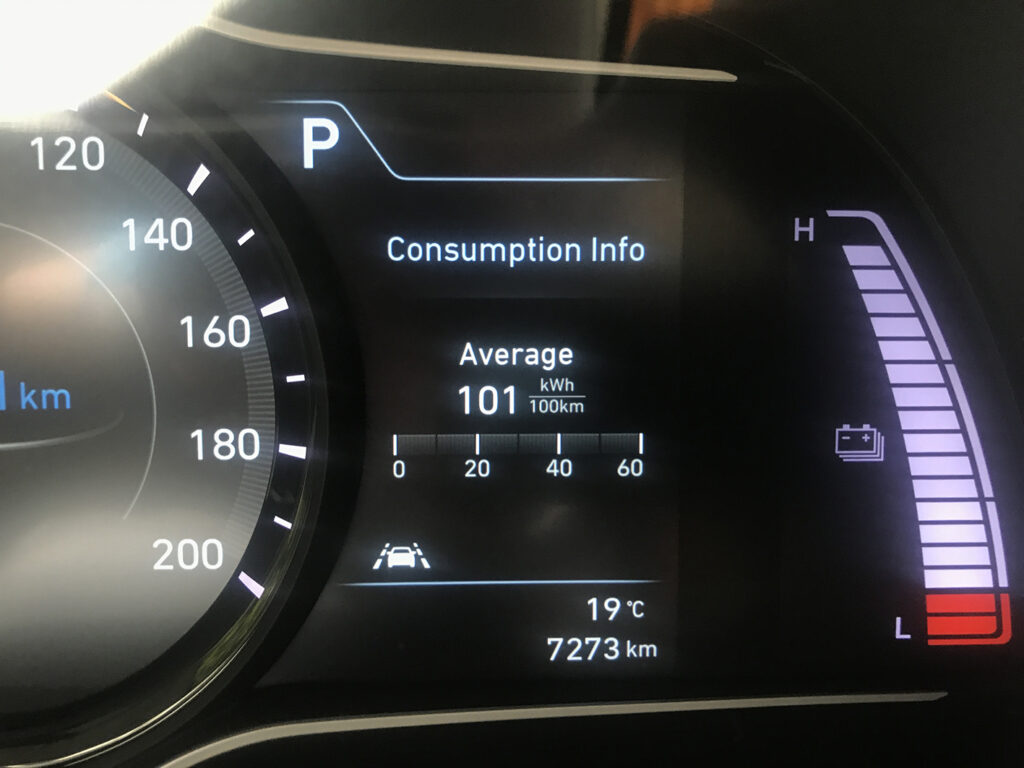
What genuinely surprised was the amount of attention the Kona Electric received during race weekend. I won’t lie, I overheard a pair questioning – with some colourful language – what the point of such a car was, and why it was here. Their t-shirts suggested an allegiance more towards V8 utes and circle work – but as the weekend went on more competitors were politely asking us questions about the Hyundai.
More than a few showed surprise at the times it achieved, and were curious about its range, 0-100km/h time, price and charging times. It’s about winning hearts and minds one step at a time.
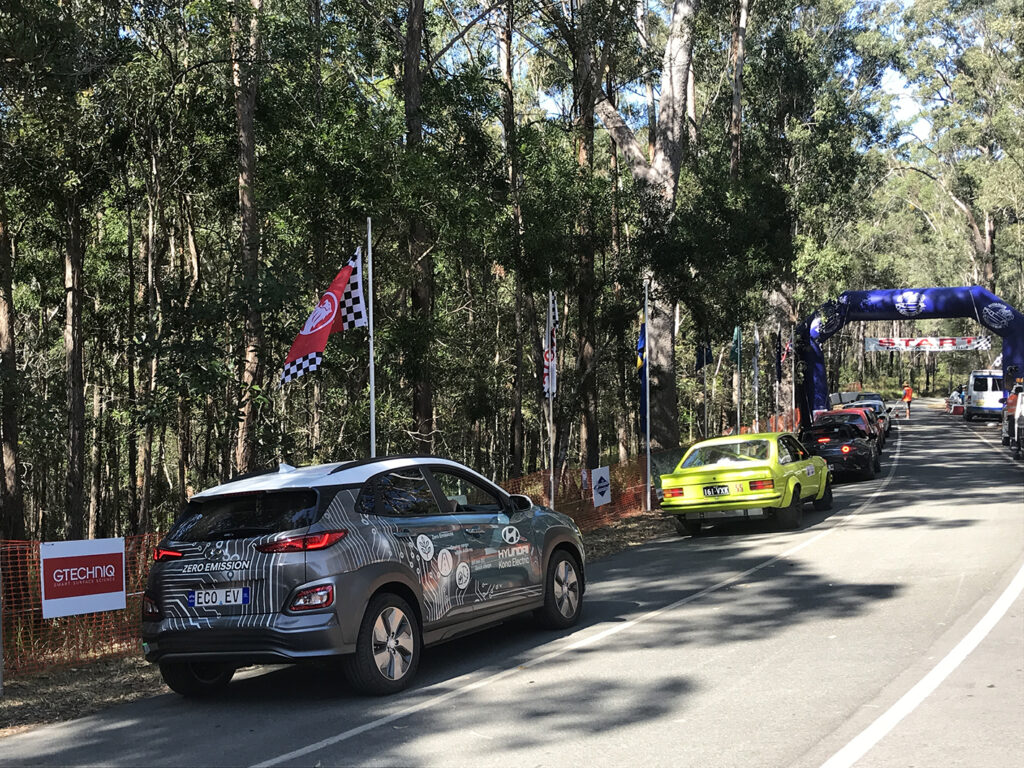
Electric cars can’t hope to replace the assault-on-the-senses internal combustion motor sport we have enjoyed for over a century; Formula E hasn’t gripped the population as much as Formula 1 manages. That said, Ken Block’s latest electric Ford Fiesta rally car sounds as good as any EV we’ve heard.
From a driving perspective there’s still much fun to be had. The Kona Electric was never supposed to be used in motor sport, but at the Noosa Hill Climb it gave an impressive account of itself.
Thrills were different, but the raw speed and instant acceleration were convincing. A Tesla Model 3 being one of the fastest overall at Noosa showed the potential for sportier EVs, and it’s easy to imagine electric racers soon winning events such as this outright.
How will that go down in a paddock filled with classic single seaters, rally cars and thumping V8s? Probably not going to be pretty, is it?

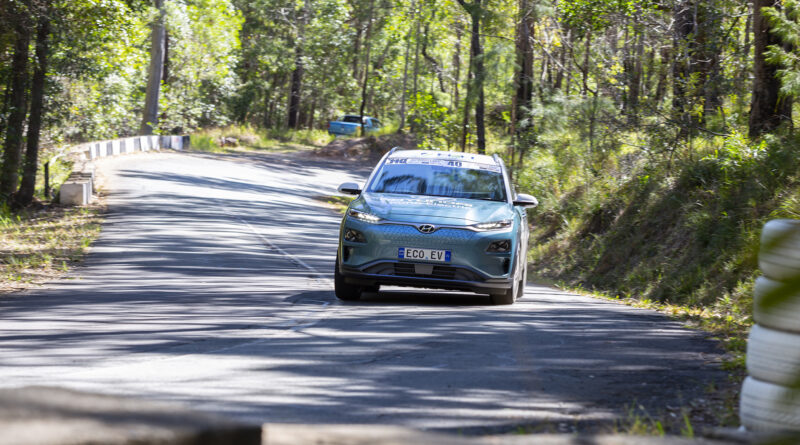

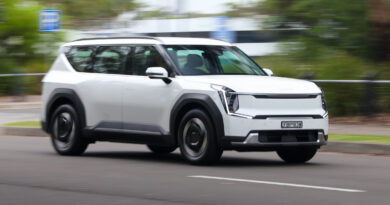
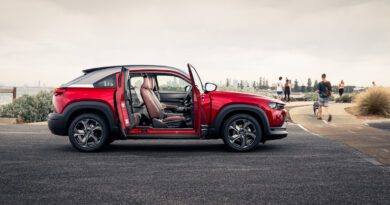
An enjoyable read, thanks Iain.
A great example of reality biting; EVs are tailor-made for hill climbing.
For a car in stock trim that’s a sobering result for fossil-fuelled cars.
How much could you shave off if you modified the Kona?
Many thanks for your thoughts Chris, and you’re right, that instant torque hit is hugely beneficial for this type of motor sport. Little wonder Teslas in particular are becoming more popular (and successful) at hill climbs.
Weight is the Kona Electric’s biggest handicap. If Hyundai Australia had let us (we didn’t ask, to be fair), stripping the cabin and removing about 90% of the battery pack (who needs range on a 1.5km hill climb?) would have helped it go far faster. Bigger brakes, cut slick tyres, race suspension…where do you stop?
Best thing was it did the event, we drove it home to charge it and the following morning the child seats were in and it was back to school drop-off duties.
Thanks for a great weekend and following up with an awesome story.
Electric racing still has a way to go to match the appeal for spectators. But from a driver’s perspective it is every bit as fun. With racing winning often depends on a massive financial commitment. But I have proven it can be done on a tight budget. My car may have cost 10% of the Tesla’s price but I guarantee I had 100% as much fun.
Many thanks Greg, and lovely to meet you and the Batt Mobile. Impressive stuff.
You’re right about the spectator appeal – maybe electric racing is made for coronavirus times when fans are banned!
See you at the next one I hope
Hey Iain, Just a observation followed by a suggestion.
I notice there are two distinct stories. One is centred on the video while the other is centred on the write up. From a reader’s perspective it is easy to read one and think that’s it when in fact there is more to see in the other story. I wonder if a link at the end of each story back to the other story might make it more obvious.
Regards Greg
Thanks for the suggestion Greg. We’ve now included a link from the video back to this article – hopefully that will make it more obvious. As for watching the video, it’s embedded towards the top of this article.
Great to know EVs are turning heads, especially when the heads don’t need ear defenders to watch the autos whoosh by. I wonder how much lighter a stripped out Kona EV would be and how the times could differ?